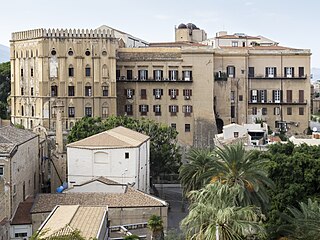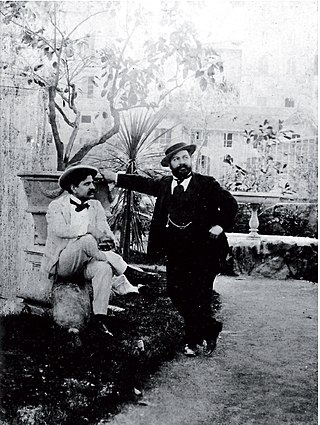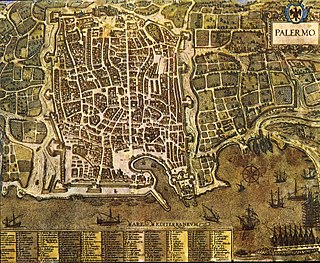
Palermo is a city in southern Italy, the capital of both the autonomous region of Sicily and the Metropolitan City of Palermo, the city's surrounding metropolitan province. The city is noted for its history, culture, architecture and gastronomy, playing an important role throughout much of its existence; it is over 2,700 years old. Palermo is in the northwest of the island of Sicily, by the Gulf of Palermo in the Tyrrhenian Sea.

The Palazzo dei Normanni is also called Royal Palace of Palermo. It was the seat of the Kings of Sicily with the Hauteville dynasty and served afterwards as the main seat of power for the subsequent rulers of Sicily. Since 1946 it has been the seat of the Sicilian Regional Assembly. The building is the oldest royal residence in Europe; and was the private residence of the rulers of the Kingdom of Sicily and the imperial seat of Frederick II and Conrad IV.

The Church of St. Mary of the Admiral, also called Martorana, is the seat of the Parish of San Nicolò dei Greci, overlooking the Piazza Bellini, next to the Norman church of San Cataldo and facing the Baroque church of Santa Caterina, in Palermo, Italy.

San Giovanni degli Eremiti is an ancient former monastic church located on Via Benedettini #19 in the ancient quarter of Albergaria of the city of Palermo, region of Sicily, Italy. It is about two blocks south from the Palazzo dei Normanni, adjacent to the church of San Giorgio in Kemonia. While the interior is virtually devoid of decoration or furnishings, the red Norman-Byzantine domes, the medieval cloister ruins, and garden make this small church a symbol of ancient Palermo.

Mario Rutelli was an Italian sculptor.
Raffaele Ganci was a member of the Mafia in Sicily from the Noce neighbourhood in Palermo. He was considered to be the right-hand man of Cosa Nostra boss Totò Riina and sat on the Sicilian Mafia Commission.
The following is a timeline of the history of the city of Palermo, Sicily, Italy.

Palermo, main city of Sicily, has a big heritage of churches which ranges from the Arab-Norman-Byzantine style to the Gothic and the Baroque styles. In particular, the list includes the most important churches of the historic centre divided by the four areas of Kalsa, Albergaria, Seralcadi and Loggia.

Santa Caterina d'Alessandria or Saint Catherine of Alexandria is a Roman Catholic church with a main facade on Piazza Bellini, and a lateral Western facade facing the elaborate Fontana Pretoria, in the historic quarter of Kalsa in the city of Palermo, region of Sicily, Italy. In front of the main facade, across the piazza Bellini, rise the older churches of San Cataldo and Santa Maria dell'Ammiraglio, while across Piazza Pretoria is the Theatine church of San Giuseppe and the entrance to the Quattro Canti. Refurbished over the centuries, the church retains elements and decorations from the Renaissance, Baroque, and late-Baroque (Rococo) eras. This church is distinct from the Oratorio di Santa Caterina found in the Olivella neighborhood.

The Praetorian Fountain is a monumental fountain located in Piazza Pretoria in the historic center of Palermo, region of Sicily, Italy. The fountain dominates the piazza on the west flank of the church of Santa Caterina, and is one block south of the intersection of the Quattro Canti. The fountain was originally built in 1544 in Florence by Francesco Camilliani, but was sold, transferred, and reassembled in Palermo in 1574.

The Praetorian Palace, also known as Palace of the Eagles, is a palace of Palermo. The building has an important role in the political life of the city, since it houses the mayor and the offices of the municipality of Palermo. It is located in the heart of the historic centre, between Via Maqueda, Piazza Pretoria and Piazza Bellini, in the same area of other well-known architectural landmarks like the Fontana Pretoria, the Baroque church of Santa Caterina and the Medieval churches of Martorana and San Cataldo.

Porta Nuova is a monumental city gate of Palermo. It represents the entrance of the Cassaro from Corso Calatafimi and is located beside Palazzo dei Normanni, royal palace of Palermo. The gate was built to celebrate Charles V's conquest of Tunis (1535) and his visit to the capital of the Kingdom of Sicily.

The Cassaro is the most ancient street of Palermo. From the late 16th century the street also had the name Via Toledo. Following the unification of Italy, it was officially renamed Via Vittorio Emanuele II, but the old and distinctive name is still in use. The street is rooted in the age of the foundation of Palermo by the Phoenicians. It provides access to a number of important sights, including the Royal Palace and the Cathedral, two UNESCO World Heritage Sites.

Piazza Marina is a square of Palermo. It is located down the Cassaro street, in the quarter of the Kalsa, within the historic centre of Palermo. The square is dominated by the great Garibaldi Garden.

The following outline is provided as an overview of and topical guide to Rome:

The following outline is provided as an overview of and topical guide to Milan:

The following outline is provided as an overview of and topical guide to Turin:

During World War II the Italian city of Palermo, the regional capital and largest city of Sicily, was heavily bombed by both the Royal Air Force and the United States Army Air Force.
Giuseppe Patricolo was an Italian architect and engineer, best known for restoring many of the medieval, including Norman architecture, buildings in and near his native Palermo in Sicily.



































